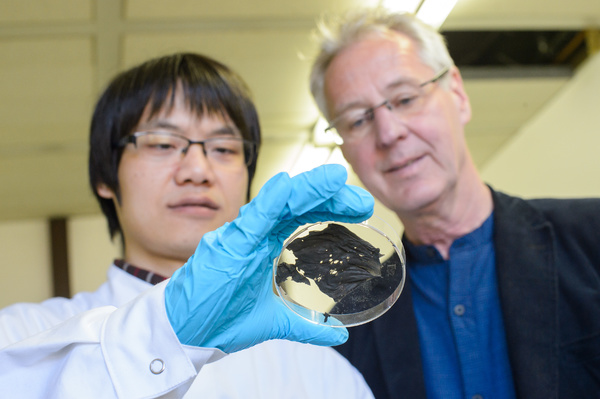|
physicists from saarland university and the leibniz institute for new materials (inm), both in saarbrucken, germany, have developed an ultrathin nanomaterial from plastic fibers and high-temperature superconducting nanowires that is as flexible as cling film and below -200°c conducts electricity without loss, levitates magnets, and can screen magnetic fields.

what looks like a pretty unremarkable piece of burnt paper is in fact
an ultrathin superconductor that has been developed by the team
led by uwe hartmann (right) shown here with doctoral student xianlin zeng.
(saarland university)
this breakthrough could lead to a host of new coating materials for aerospace and medical technologies.
this new material is pliable and adaptable, according to a report from saarland university, can be made to any size and is cheaper to construct than previous attempts at superconducting ceramics. it also weighs about 100 times less than a typical superconductor.
to weave the new material, the scientists used a technique called electrospinning, which forces a liquid through a very fine nozzle (known as a spinneret) with an electrical voltage applied to it. this process creates nanowire filaments, which are then heated to create the correct superconductor composition.
although the final product looked like a charred piece of paper, the thin film is a remarkable breakthrough in the creation of nanomaterials films.
the researchers have published several papers highlighting their work on this project. the most recent was published in superconductor science and technology. the abstract stated:
“bi2sr2cacu2o8 (bi-2212) superconducting nanowires are synthesized by the electrospinning method. two different precursors were employed to grow the nanowires, a pb-doped one and a cu,ca-enriched one. the granular polycrystalline character was confirmed by scanning electron microscopy and x-ray diffraction measurement.
“the magnetic and electric properties of the samples were investigated via squid magnetometry and four-probe resistance measurements. the superconducting transition temperatures of the two systems were found to be similar (pbdoped 84 k, cu,ca-enriched 76 k), but the transition width and the onset of irreversibility were clearly different.
“the magnetization loops and the resistance data demonstrate that the cu,ca enriched precursor yields samples with better superconducting properties.”
read other research reports at http://aip.scitation.org/doi/10.1063/1.4944747, https://www.researchgate.net/publication/301240247_transport_and_magnetic
_measurements_on_bi2sr2cacu2o8_nanowire_networks_prepared_via_electrospinning,
and http://iopscience.iop.org/article/10.1088/2053-1591/2/9/095022/meta.
|